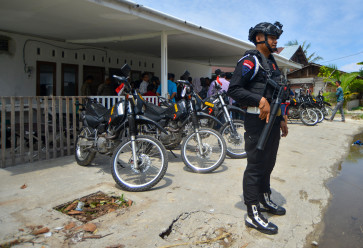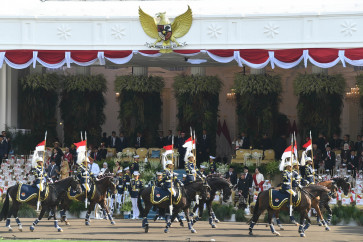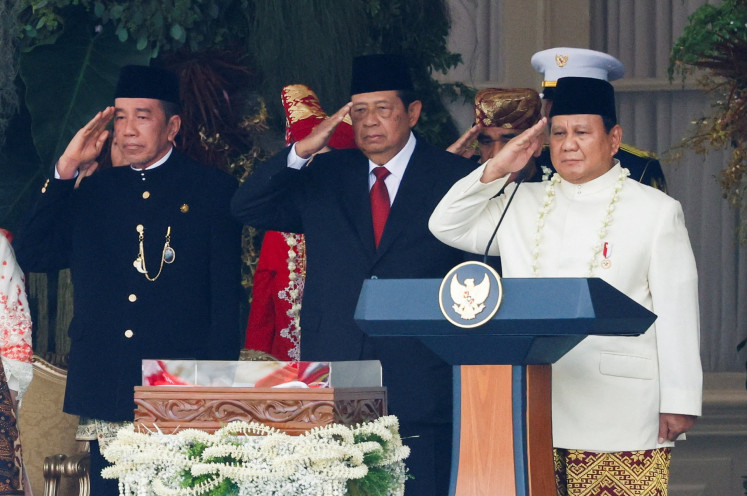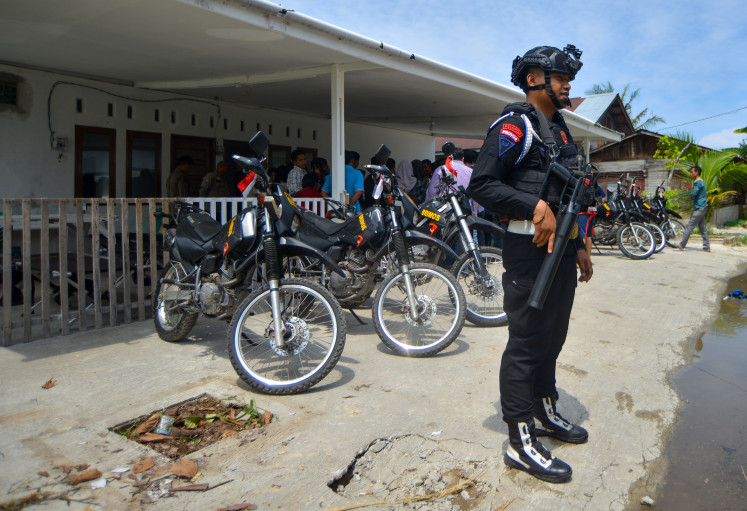Popular Reads
Top Results
Can't find what you're looking for?
View all search resultsPopular Reads
Top Results
Can't find what you're looking for?
View all search resultsMinisters join hands to look after lakes
After years of neglect and unclear management, nine ministers are teaming up to improve the way the country’s lakes are looked after, and restore ailing lakes functioning as water reserves in the dry season
Change text size
Gift Premium Articles
to Anyone
After years of neglect and unclear management, nine ministers are teaming up to improve the way the country’s lakes are looked after, and restore ailing lakes functioning as water reserves in the dry season.
The nine ministers included Home Minister Mardiyanto, Public Works Minister Djoko Kirmanto, Forestry Minister MS Kaban, Agriculture Minister Anton Apriyantono, Maritime Affairs and Fisheries Minister Freddi Numbery, Energy and Mineral Resources Minister Purnomo Yusgiantoro, Culture and Tourism Minister Jero Wacik, State Minister of Research and Technology Kusamayanto Kadiman and State Minister for the Environment Rachmat Witoelar.
These ministers are slated to hold a national conference on issues pertaining to the management of the country’s lakes, from Aug. 13 to 15, in Bali.
“The conditions of lakes is a reflection of the environmental health of the respective areas,” Rachmat told reporters Tuesday.
Indonesia has about 840 lakes containing 72 percent of the total surface water in Indonesia.
Rachmat said most lakes were in poor condition as a result of massive forest conversions into agricultural and housing areas in neighboring areas.
“None of our lakes have potable water like many lakes in European countries,” he said.
During the conference, the ministers are expected to issue a joint agreement on sustainable lake management, which will deal with climate change issues and bring back the lakes’ function as reservoirs of water during the dry season.
The agreement will include the management of lake ecosystems to help reduce the level of polluted river waters entering lakes and to enforce spatial planning around lakes.
The ministers will also develop systems to monitor the lakes.
“The conference will issue a plan of action to address how lakes will adapt to and mitigate the risks of climate change, since most of the water will come from lakes during the dry season,” said Masnellyarti Hilman, deputy minister for natural conservation enhancement and environmental destruction control.
The conference will also invite all Indonesian governors and representatives from international financial institutions such as the World Bank.
Masnellyarti said the ministers would prioritize the restoration of 30 of Indonesia’s most ailing lakes, including Limboto lake in Gorontalo, Tempe lake in South Sulawesi and Toba lake in North Sumatra.
“If there are no rehabilitation efforts, Limboto Lake will dry out in 2034, leaving Gorontalo as a swamp city,” she said.
Masnerllyarti said there used to be 22 rivers supplying waters to Limbato lake even during the dry season. However, there were currently only two rivers still suppling water during the dry season.
She said sedimentation levels in Tempe lake and Toba lake were a grave concern, at between one and three centimeters per year.
“We predict the Tempe lake will be waterless during the dry season by 2018,” she said.
Meanwhile, there are 77,277 hectares of land around Toba lake in critical condition, with only 39,765 hectares of forests.
“This has caused high sedimentation levels in the Toba lake,” said Masnellyarti.
The 2007 State of Environment Report in Indonesia revealed the water from rivers, basins and lakes continued to be severely polluted by domestic and industrial waste, despite remaining the main sources of drinking water.
The report’s findings — based on the survey of 33 rivers in 30 provinces — found that most rivers were moderately to severely polluted.
The survey focused on 16 parameters, including biochemical oxygen demand (BOD), chemical oxygen dioxide (COD), pH levels as well as fecal coli.
In terms of pollutants affecting the BOD — the total oxygen required by microorganisms to decompose organic substances in sewage — water in most of the rivers was no longer suitable as drinking water.
The Public Works Ministry predicted the country would need more than 311 million cubic meters of drinking water in 2012 because of the population boom.










